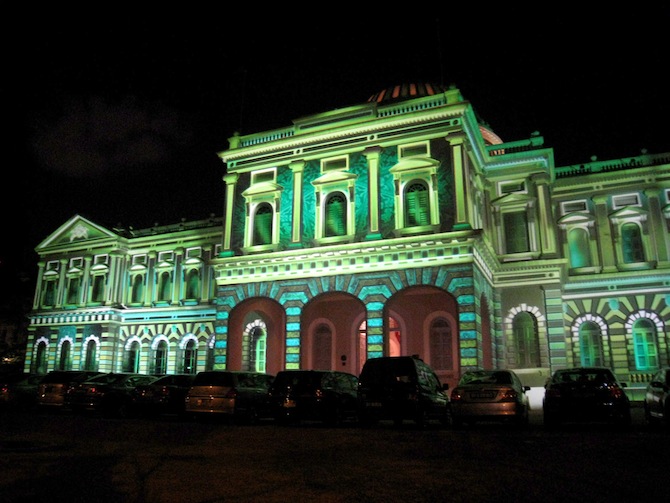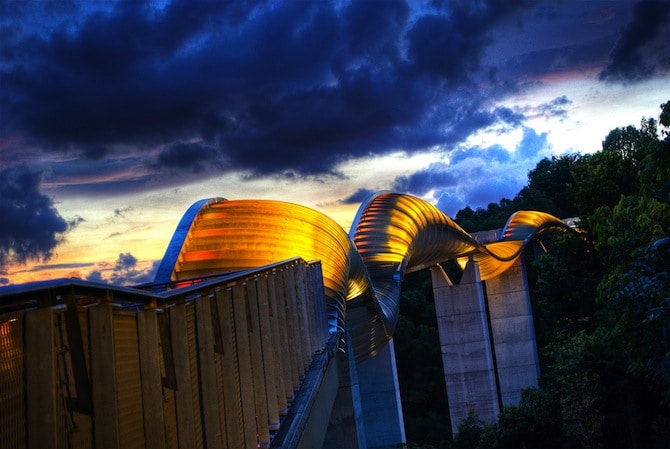Singapore is one of the world’s smallest countries and is known for its food and its architecture which reflects the destination’s rich heritage, multi-cultural society and modern influences. Some of the top Singapore architecture attractions include:
Sri Mariamman Temple
As the oldest Hindu temple in Singapore, it’s hard to believe that this magnificent six-tier structure was once a humble wooden hut. The temple features a gopuram (grand tower entrance) embellished with sculptures of Hindu deities and ornamental decorations. The vibrant painted sculptures are made of plaster, which allows for fine detailing. Within the walled compound, you will find richly ornamented columns and frescoes decorating the ceiling of the prayer area. While you can tour the temple for free, a small fee is charged for cameras.
Tip: If you’re visiting in October, don’t miss the Timiti fire-walking ceremony held here a week before Diwali, the Hindu festival of light.

Singapore’s Helix Bridge. Photo courtesy of Rajesh Pamnani.
Buddha Tooth Relic Temple
The bright red pillars, green windows and outstretched eaves of the Buddha Tooth Relic Temple stand out in the heart of Chinatown. From the timber finishes to the bronze roof ornaments at each pagoda, the temple’s facade is heavily inspired by the Tang Dynasty style. A closer look at the temple’s pillar bases reveal intricate engravings of lotus petals. The grand, five-storey temple houses what the Buddhists regard as the Sacred Buddha Tooth relic as well as a culture museum and a reference library.
Tip: A free tour of the museum and relic chamber takes place every Tuesday and Thursday at 2pm. Dress conservatively before entering.

Sri Mariamman. Photo courtesy of Andrea Schaffer.
The Helix Bridge
This 280 meter (919 foot) pedestrian bridge was built with two spiraling helix tubes to mimic the form of a DNA structure. Linking the Marina Centre to the Marina Bay Sands, the curved form of the bridge exhibits an elegant and lightweight appearance that complements the city’s urban infrastructures. Take in the stunning views of Singapore’s skyline at one of the bridge’s four viewing platforms.
Tip: For a greater visual experience, visit the Helix Bridge at night for it is illuminated by a series of lights that further enhance the double-helix structure.

Esplanade. Photo courtesy of Edwin Lee.
Esplanade – Theatres on the Bay
Nicknamed “the durian” for its resemblance to the giant tropical fruit, the spiky facade of Singapore’s performing arts centre is hard to miss. Originally designed with a glass exterior in mind, a cladding of triangular aluminum sun shields was added to the final design for an essentially glazed look that fits with the city’s tropical climate. The shields are set to be open or closed depending on the angle in which the sun hits them, so the glass facades are protected from direct sunlight without limiting the views.
Tip: For an overview of Esplanade’s architecture and history, book a tour beforehand. Tours are available Tuesday through Sunday.

National Museum. Photo courtesy of Suhana Sol.
National Museum Of Singapore
Erected in 1887, the National Museum was designed in Neo-Palladian style with two rectangular blocks and a dome at the entrance. While it has undergone many expansions over the years, much of the old building is beautifully restored with its city facade. The Glass Passage, one of the museum’s new features, allows visitors a clear view of the museum’s Dome with its elegant Palladian motifs. The Glass Passage conveys the experience of viewing the old building in an art gallery setting.
Tip: If you’re visiting in August, time your visit with the Night Festival where spectacular light installations will illuminate the museum’s facade.

Henderson Waves. Photo courtesy of Erik Yeoh.
Henderson Waves
At 18 feet (5.5 meters) tall, Henderson Waves is the tallest pedestrian bridge in Singapore that offers tranquility among the greenery. The bridge has a wave form made up of seven undulating curved steel ribs that rise over and under its deck. The curved ribs form alcoves that function as shelters with seats within. Thousands of yellow salts made of balau wood — an all-weather timber found in Southeast Asia — were used to compose the deck.
Tip: Stay on to admire the bridge illuminated with LED lamps from 7pm to 2am daily.
Contributed by Suhana Sol writes at SuhanaSol.com, a website focused on travel and social good.

Jessica Festa is the editor of the travel sites Jessie on a Journey (http://jessieonajourney.com) and Epicure & Culture (http://epicureandculture.com). Along with blogging at We Blog The World, her byline has appeared in publications like Huffington Post, Gadling, Fodor’s, Travel + Escape, Matador, Viator, The Culture-Ist and many others. After getting her BA/MA in Communication from the State University of New York at Albany, she realized she wasn’t really to stop backpacking and made travel her full time job. Some of her most memorable experiences include studying abroad in Sydney, teaching English in Thailand, doing orphanage work in Ghana, hiking her way through South America and traveling solo through Europe. She has a passion for backpacking, adventure, hiking, wine and getting off the beaten path.








